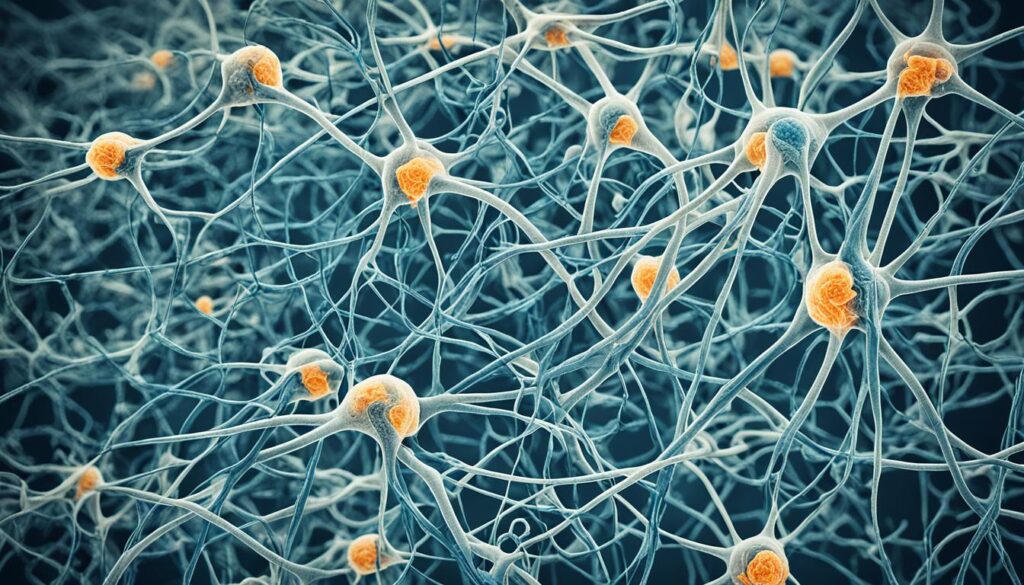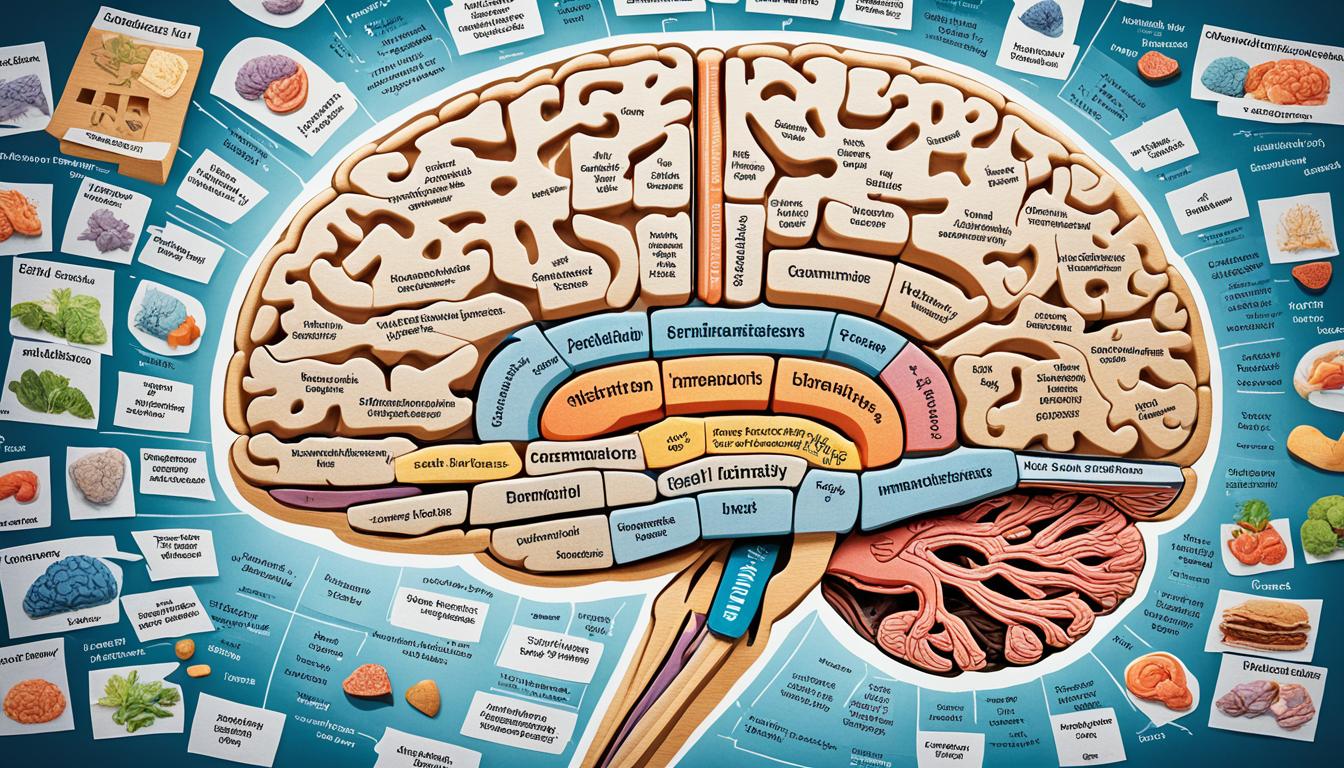Did you know that dementia affects an estimated 50 million people worldwide, with Alzheimer’s disease being the leading cause of dementia? Let’s know what causes dementia and Alzheimers.
Dementia and Alzheimer’s are complex neurodegenerative disorders that pose significant challenges to individuals, families, and healthcare systems. As the number of cases continues to rise, it is crucial to understand the underlying causes of these conditions to better equip ourselves with knowledge for prevention and early intervention.
In this article, we will delve into the main causes of dementia and Alzheimer’s, explore the common symptoms and warning signs, and shed light on the various factors that contribute to their development. By gaining a deeper understanding of these causes, we can work towards reducing the risk and improving the quality of life for those affected by dementia and Alzheimer’s disease.
Key Takeaways:
- Dementia affects around 50 million people around the world.
- Alzheimer’s disease is the leading cause of dementia.
- Understanding the causes of dementia and Alzheimer’s is crucial for prevention and early intervention.
- Recognizing the common symptoms and warning signs is essential in identifying cognitive decline.
- Various factors contribute to the development of dementia and Alzheimer’s, including genetics, lifestyle choices, and environmental influences.
Demystifying Dementia and Alzheimer’s Disease
In this section, we will provide a comprehensive understanding of dementia and Alzheimer’s disease. We will define what dementia is and explain the specific characteristics of Alzheimer’s disease. Additionally, we will highlight the key differences between Alzheimer’s and dementia. Finally, we will discuss the common symptoms and warning signs associated with these conditions, helping readers recognize potential indicators of cognitive decline.
Defining Dementia and Alzheimer’s
Dementia is a broad term used to describe a set of symptoms that affect memory, thinking, and social abilities severely enough to interfere with daily life. It is caused by damage to brain cells and affects various cognitive functions. Alzheimer’s disease, on the other hand, is a specific form of dementia and the most common cause of cognitive decline in older adults. It is characterized by the accumulation of beta-amyloid plaques and tau tangles in the brain, which disrupt the normal functioning of neurons.
The Difference Between Alzheimer’s vs Dementia
While Alzheimer’s disease causes a type of dementia, not all dementia cases. Dementia is an umbrella term that encompasses several different diseases and conditions, including Alzheimer’s, vascular dementia, Lewy body dementia, frontotemporal dementia, and more. The key distinction between Alzheimer’s and other forms of dementia lies in the specific brain changes and underlying causes.
Common Symptoms and Warning Signs
The symptoms of dementia and Alzheimer’s can vary depending on the stage of the disease and the specific underlying cause. However, some common symptoms include:
- Memory loss
- Difficulty with problem-solving and planning
- Confusion and disorientation
- Difficulty completing familiar tasks
- Misplacing items or putting them in unusual places
- Changes in mood and personality
- Withdrawal from social activities
- Poor judgment and decision-making
- Trouble with language and communication
These symptoms can be early indicators of cognitive decline and should be cause for further evaluation and discussion with a healthcare professional.
Identifying the Main Cause of Alzheimer’s Disease
In this section, we will explore the main cause of Alzheimer’s disease and delve into the underlying factors that contribute to the development of this neurodegenerative disorder. Through an examination of scientific research and current understanding, we aim to uncover valuable insights that can enhance our understanding of the disease and inform potential strategies for prevention and treatment.
Alzheimer’s disease is a complex condition with multifactorial causes. While the exact cause remains elusive, extensive research suggests that a combination of genetic, environmental, and lifestyle factors contribute to its manifestation. Identifying the primary cause is crucial for developing effective prevention and treatment approaches.

Research has shown that the accumulation of beta-amyloid plaques and tau tangles in the brain plays a central role in the development of Alzheimer’s disease. These abnormal protein deposits disrupt neural communication and lead to the degeneration of brain cells and cognitive decline.
Genetic factors also play a significant role in Alzheimer’s disease. Mutations in genes such as APP, PSEN1, and PSEN2 have been linked to the early-onset familial form of the disease. Additionally, the presence of the APOE ε4 allele increases the risk of developing late-onset Alzheimer’s.
Environmental factors, such as exposure to toxins and pollutants, may contribute to the development of Alzheimer’s disease. Chronic conditions like cardiovascular disease and diabetes have also been associated with an increased risk of cognitive decline.
While there is no definitive cure for Alzheimer’s disease, ongoing research aims to identify novel interventions and treatment options. Understanding the main cause of Alzheimer’s disease is essential for developing effective strategies to prevent and slow down its progression, ultimately improving the quality of life for individuals affected by this devastating condition.
Exploring What Causes Dementia and Alzheimers
Addressing Genetic Factors in Alzheimer’s and Dementia
In the quest to understand the causes of dementia and Alzheimer’s disease, genetic factors play a significant role. While not all cases of these conditions are directly linked to genetics, certain gene variations can increase the risk of developing dementia. Research has identified specific genes, such as the APOE ε4 allele, that are associated with a higher susceptibility to Alzheimer’s disease. By studying the influence of genetic factors, scientists can gain insights into the mechanisms underlying the development of these cognitive disorders.
Lifestyle and Environmental Impact on Cognitive Health
Beyond genetics, lifestyle factors also contribute to the risk of dementia and Alzheimer’s. Engaging in regular physical exercise, maintaining a healthy diet rich in nutrients, and staying mentally active are all crucial in promoting cognitive health. Additionally, environmental factors can influence brain health. Long-term exposure to toxins, such as air pollution and heavy metals, may increase the risk of cognitive decline. Understanding the impact of lifestyle choices and environmental factors is imperative for preventive strategies and overall brain health.
Medical Innovations and Diagnostics in Dementia Research
Advancements in medical research and diagnostic tools have revolutionized our understanding of dementia and Alzheimer’s. Cutting-edge technologies, such as brain imaging techniques and biomarker analysis, allow for early detection and accurate diagnosis of these conditions. Innovative approaches, including precision medicine and gene therapies, offer promising avenues for targeted treatments. Through ongoing research and technological breakthroughs, scientists strive to unravel the complexities of these diseases and develop effective interventions for individuals at risk.

| Factors | Genetic | Lifestyle | Environmental |
|---|---|---|---|
| Role | Increased risk | Contributes to prevention | Potential influence |
| Impact | Specific gene variations | Physical exercise, diet, mental stimulation | Toxins, air pollution, heavy metals |
| Innovations | Gene therapies, precision medicine | Advancements in lifestyle interventions | Improved environmental monitoring |
Cutting-edge research and Technological Breakthroughs
In this section, we will delve into the cutting-edge research in dementia and Alzheimer’s disease, as well as the technological breakthroughs that have revolutionized the field of dementia research.

Researchers and scientists are constantly pushing the boundaries of knowledge in their quest to understand the causes and potential treatments for dementia and Alzheimer’s disease. Through scientific studies and clinical trials, groundbreaking advancements have been made in unravelling the complexities of these conditions.
One area of cutting-edge research focuses on exploring the underlying causes of dementia and Alzheimer’s. Scientists are uncovering new insights into the genetic, environmental, and lifestyle factors that contribute to the development of these diseases. This invaluable knowledge not only enhances our understanding of dementia and Alzheimer’s but also paves the way for innovative approaches to prevention and treatment.
Technological advancements have played a pivotal role in advancing dementia research. High-tech imaging techniques, such as positron emission tomography (PET) scans and magnetic resonance imaging (MRI), provide detailed insights into the brain’s structure and function, aiding in early detection and diagnosis.
Additionally, sophisticated neurocognitive assessments are being developed, using digital platforms and artificial intelligence algorithms to assess cognitive abilities and detect subtle changes in memory, thinking, and behavior. These technological breakthroughs have revolutionized the diagnostic capabilities of healthcare professionals, enabling earlier detection and intervention.
Moreover, big data analysis and the application of machine learning algorithms are uncovering patterns and correlations within vast amounts of information, leading to new discoveries and potential therapeutic strategies. This data-driven approach has the potential to transform the field of dementia research, paving the way for personalized treatments tailored to an individual’s unique needs.
Collaboration between researchers, healthcare professionals, technology experts, and pharmaceutical companies is key to continuing the momentum of cutting-edge research and innovation in dementia and Alzheimer’s. By harnessing the power of interdisciplinary collaboration, we can accelerate the development of groundbreaking treatments and interventions that will improve the lives of individuals affected by these devastating conditions.
The Role of Lifestyle Factors in Dementia and Alzheimer’s Prevention
In the quest to prevent and reduce the risk of dementia and Alzheimer’s disease, lifestyle factors play a crucial role. Making conscious choices regarding diet, exercise, and overall health can have a significant impact on cognitive well-being. Research has shown that certain habits and behaviors can either increase or decrease the risk of developing these conditions.
Impact of Diet and Exercise on Dementia Risk
Proper nutrition and regular physical activity have been linked to a reduced risk of dementia and Alzheimer’s disease. A healthy diet rich in fruits, vegetables, whole grains, lean proteins, and omega-3 fatty acids can provide vital nutrients that support brain health. On the other hand, a diet high in saturated fats, refined sugars, and processed foods may increase the risk of cognitive decline.
Physical exercise is not only beneficial for cardiovascular health but also for brain health. Regular aerobic exercise, such as brisk walking, swimming, or cycling, can improve blood flow to the brain, promote neuroplasticity, and reduce the risk of dementia.
Understanding the Connection Between Health Conditions and Cognitive Decline
Several health conditions have been found to be associated with an increased risk of cognitive decline and the development of dementia. Chronic conditions such as cardiovascular disease, diabetes, hypertension, and obesity can impair blood flow to the brain or lead to inflammation, both of which contribute to the progression of cognitive decline. By managing and treating these health conditions effectively, individuals can potentially lower their risk of developing dementia.
Preventive Strategies for Dementia and Alzheimer’s
Prevention is key when it comes to dementia and Alzheimer’s disease. While there is no guaranteed way to prevent or completely eliminate the risk, taking proactive measures can help reduce the likelihood of developing these conditions. Here are some preventive strategies that individuals can incorporate into their lives:
- Maintain a healthy diet rich in brain-boosting nutrients.
- Engage in regular physical exercise to promote brain health and blood flow.
- Keep the mind active through intellectual stimulation, such as reading, puzzles, or learning new skills.
- Manage and control chronic health conditions that may contribute to cognitive decline.
- Practice good sleep hygiene to support optimal brain function.
- Stay socially connected and engage in meaningful relationships.
- Reduce stress levels through relaxation techniques, such as meditation or yoga.
By implementing these preventive strategies, individuals can take proactive steps towards maintaining their brain health and reducing the risk of dementia and Alzheimer’s disease. Remember, small lifestyle changes can have a big impact on long-term cognitive well-being.
Elucidating Types of Dementia and Their Triggers
In this section, we will delve into the different types of dementia and the specific causes associated with each. Understanding these types and their triggers is crucial in comprehending the complexities of dementia and Alzheimer’s disease.
Various Types and Their Distinct Causes
There are several types of dementia, each with its own distinct set of causes. The most common types include:
- Alzheimer’s disease: A progressive brain disorder characterized by the buildup of abnormal protein clumps and tangled nerve fibers.
- Vascular dementia: Caused by impaired blood flow to the brain, typically resulting from stroke or other conditions that affect the blood vessels.
- Lewy body dementia: Associated with the abnormal protein deposits in the brain called Lewy bodies.
- Frontotemporal dementia: Affecting the frontal and temporal lobes of the brain, leading to changes in behavior, personality, and language.
The causes of these types of dementia can vary, ranging from genetic factors to underlying medical conditions and cognitive disorders.
What 7 Things Trigger Alzheimer’s?
Alzheimer’s disease, the most common form of dementia, can be triggered by various factors. Here are seven key triggers to be aware of:
- Age: Advancing age is the primary risk factor for developing Alzheimer’s, with the likelihood increasing after the age of 65.
- Family history and genetic factors: Individuals with a family history of Alzheimer’s and certain gene mutations are at a higher risk.
- Down syndrome: People with Down syndrome are more likely to develop Alzheimer’s due to genetic factors.
- Head injuries: Severe head injuries, especially those involving loss of consciousness, can increase the risk of Alzheimer’s later in life.
- Cardiovascular conditions: Chronic conditions such as high blood pressure, heart disease, and diabetes can contribute to the onset of Alzheimer’s.
- Poor sleep patterns: Chronic sleep disturbances and poor sleep quality may be linked to an increased risk of Alzheimer’s disease.
- Mental and social engagement: A lack of mental and social stimulation throughout life may be associated with a higher risk of developing Alzheimer’s.
Environmental Triggers for Dementia and Alzheimer’s
Aside from the individual triggers mentioned above, certain environmental factors can also contribute to the development of dementia and Alzheimer’s. These can include:
- Air pollution
- Heavy metal exposure
- Chemical exposures
- Poor diet and nutrition
- Limited access to education and intellectual activities
It is important to understand and mitigate these environmental triggers to reduce the risk of developing dementia and Alzheimer’s disease.
Conclusion
In conclusion, throughout this article, we have explored the various factors that contribute to the development of dementia and Alzheimer’s disease. By understanding the underlying causes and risk factors associated with these conditions, we are better equipped to take proactive steps towards prevention and early intervention.
Key factors that play a significant role in the development of dementia and Alzheimer’s include genetic predisposition, lifestyle choices, and environmental influences. Genetic factors, such as certain gene mutations, can increase the likelihood of developing these conditions. Additionally, lifestyle factors, including diet and exercise, play a crucial role in cognitive health and reducing the risk of cognitive decline. The environment we live in, such as exposure to toxins and air pollution, can also impact brain health and increase the risk of dementia.
It is important to prioritize awareness and education about dementia and Alzheimer’s disease. Recognizing the common symptoms and warning signs allows for early detection and intervention, which can significantly improve outcomes for individuals and their families. By promoting brain-healthy habits, such as engaging in regular mental and physical exercise, maintaining a balanced diet, and managing chronic health conditions, we can actively reduce the risk of developing these conditions.
In conclusion, by understanding the complex causes and risk factors associated with dementia and Alzheimer’s, we can work towards the prevention and early intervention of these conditions. Through ongoing research, advancements in technology, and individual lifestyle modifications, we can strive for better brain health and improve the quality of life for those affected by dementia and Alzheimer’s disease.
FAQ
What causes dementia and Alzheimer’s?
The exact causes of dementia and Alzheimer’s disease are not fully understood. However, several factors can contribute to their development, including genetic predisposition, lifestyle choices, environmental factors, and age.
What is the main cause of dementia?
Dementia can be caused by various factors, but the most common cause is Alzheimer’s disease, accounting for approximately 60-80% of dementia cases.
What is the leading cause of dementia and Alzheimer’s?
Alzheimer’s disease is the leading cause of dementia, accounting for the majority of dementia cases worldwide.
What are the 10 warning signs of dementia?
The 10 warning signs of dementia may include memory loss, difficulty completing familiar tasks, confusion, impaired communication, poor judgment, problems with abstract thinking, mood changes, changes in personality, withdrawal from social activities, and difficulty with spatial and visual perception.
What are the differences between Alzheimer’s and dementia?
Dementia is an umbrella term that describes a set of symptoms, including cognitive decline, memory loss, and difficulty with daily activities. Alzheimer’s disease is a specific type of dementia characterized by the progressive deterioration of memory and cognitive functions.
What are the common symptoms and warning signs of dementia and Alzheimer’s?
Common symptoms and warning signs may include memory loss, confusion, difficulty with problem-solving, language problems, challenges with comprehension, changes in mood and behavior, and decreased judgment and planning abilities.
What is the main cause of Alzheimer’s disease?
The main cause of Alzheimer’s disease is still not fully understood, but it is believed to involve a combination of genetic, environmental, and lifestyle factors.
What are the genetic factors in Alzheimer’s and dementia?
Genetic factors can contribute to an individual’s risk of developing Alzheimer’s or dementia. Certain genes, such as the APOE-e4 gene, have been associated with an increased risk of developing Alzheimer’s disease.
How do lifestyle factors contribute to dementia and Alzheimer’s?
Lifestyle factors, such as diet, exercise, sleep quality, and social engagement, can influence the risk of developing dementia and Alzheimer’s. A healthy lifestyle that includes regular physical activity, a balanced diet, and brain-stimulating activities may help reduce the risk.
What are the environmental triggers for dementia and Alzheimer’s?
Environmental factors, including air pollution, exposure to toxins, and certain occupational hazards, have been suggested as potential triggers for the development of dementia and Alzheimer’s disease.
How can we prevent dementia and Alzheimer’s?
While it is not possible to prevent dementia or Alzheimer’s completely, certain lifestyle modifications, such as maintaining a healthy diet, engaging in regular physical activity, staying mentally and socially active, and managing chronic conditions, can help reduce the risk.
What are the different types of dementia and their causes?
There are various types of dementia, including Alzheimer’s disease, vascular dementia, Lewy body dementia, and frontotemporal dementia. Each type has specific underlying causes, such as protein abnormalities, blood vessel disease, or accumulations of abnormal proteins in the brain.
What are the triggers of Alzheimer’s disease?
While the exact cause of Alzheimer’s disease is still not fully understood, several factors, such as age, genetic predisposition, lifestyle choices, and oxidative stress, have been identified as potential triggers for its development.
What environmental triggers contribute to dementia and Alzheimer’s?
Environmental triggers for dementia and Alzheimer’s may include toxic exposures, air pollution, certain pesticides, head injuries, and infections. These factors can potentially increase the risk of developing these conditions.




